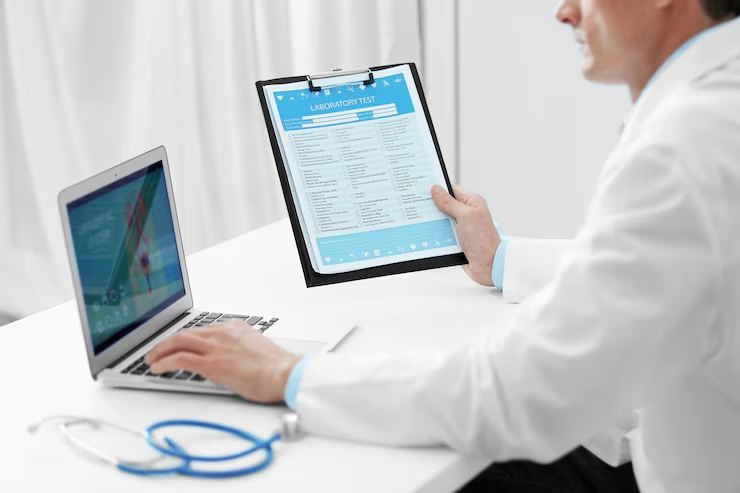Home Case Study Automating Prescription Data Entry for a Healthcare Provider
Healthcare
Automating Prescription Data Entry for a Healthcare Provider

Focus Areas
Data Integrity & Governance
Risk Management
Regulatory Compliance (HITRUST)

Business Problem
A national healthcare service provider managing electronic health records (EHR), patient communications, and provider workflows was increasingly vulnerable to sophisticated cyber threats. Data breaches and ransomware attacks in the industry highlighted the critical need for advanced security posture. The organization needed a strategy to proactively secure sensitive health data, ensure compliance, and maintain the integrity of clinical information across systems.
Key challenges:
- Outdated Security Infrastructure: Legacy systems lacked modern security controls and real-time visibility.
- Data Silos and Inconsistencies: Clinical and operational data existed in fragmented systems with inconsistent validation and audit trails.
- Reactive Incident Management: Security incidents were identified manually, with delayed containment and reporting.
Compliance Complexity: Meeting HIPAA and HITRUST requirements was a labor-intensive, documentation-heavy process.
Insider Risk Exposure: Inadequate access control and monitoring increased vulnerability to unauthorized access or data misuse.
The Approach
Curate Consultant’s deployed a modern cybersecurity and data governance framework centered around zero-trust principles, automated monitoring, and unified access controls. By integrating advanced threat detection tools and real-time data validation pipelines, the healthcare provider significantly improved both security resilience and data integrity—laying the foundation for long-term compliance and trust.
Key components of the solution:
Discovery and Requirements Gathering:
Security Maturity Assessment: Conducted audits of infrastructure, endpoints, identity management, and threat response workflows.
Stakeholder Workshops: Engaged compliance, IT, and clinical leadership to align on data protection priorities.
Policy & Workflow Mapping: Reviewed existing security policies, incident response plans, and data quality rules.
Compliance Mapping: Aligned technical requirements to HIPAA Security Rule and HITRUST CSF controls.
Solution Design and Implementation:
Unified Threat Detection Platform: Integrated SIEM (Security Information and Event Management) tools like Splunk and SentinelOne for real-time threat intelligence and log correlation.
Data Validation & Integrity Monitoring:
Built ETL pipelines with checksum verification and schema validation for clinical records.
Implemented audit logs and anomaly detection for data access and edits.
Incident Response Automation: Configured automated workflows for threat detection, alert triage, and response coordination using SOAR tools.
Compliance & Reporting Automation: Tools like Vanta and Drata were used to continuously monitor controls, manage risks, and simplify evidence collection for audits.
Process Optimization and Change Management:
Governance Council Formation: Established a security and data governance council for oversight and policy updates.
Staff Enablement: Conducted workshops and tabletop exercises to train employees on secure data handling and phishing awareness.
Ongoing Risk Review: Quarterly security reviews and compliance scorecards ensured continuous improvement.
Cross-Team Collaboration: Security, IT, data engineering, and clinical operations aligned through centralized dashboards and SLAs.
Business Outcomes
Strengthened Cyber Defense Posture
Unified threat intelligence and zero-trust architecture reduced exposure to both external attacks and insider threats.
Data Integrity at Scale
Real-time validation and automated checks enhanced the accuracy and reliability of patient data across workflows.
Regulatory Confidence and Audit Readiness
Automated evidence generation and policy monitoring ensured HIPAA and HITRUST compliance with less manual effort.
Proactive Threat Mitigation
Reduced mean time to detect (MTTD) and mean time to respond (MTTR), improving security responsiveness and minimizing impact.
Sample KPIs
Here’s a quick summary of the kinds of KPI’s and goals teams were working towards**:
| Metric | Before | After | Improvement |
|---|---|---|---|
| Mean Time to Detect (MTTD) | 28 hours | 2 hours | 93% faster detection |
| Mean Time to Respond (MTTR) | 3 days | 6 hours | 92% improvement |
| Unauthorized access attempts blocked | 400/month | 1,200/month | 3x increase in threat blocking |
| Compliance audit effort (FTE weeks) | 6 weeks | 1 week | 83% reduction |
| Data error incidents | 35 errors/month | 5 errors/month | 86% reduction |
Customer Value
Trust and Safety
Patients and partners gained confidence in secure data handling and reduced risk of exposure.
Data Reliability
Clinicians could trust the accuracy of data used in diagnosis and treatment
Sample Skills of Resources
Cybersecurity Engineers: Designed and implemented secure architecture and automated defense mechanisms.
Data Governance Experts: Defined validation rules, metadata standards, and integrity enforcement processes.
Compliance Analysts: Mapped controls to HIPAA/HITRUST requirements and managed audit readiness.
Security Operations Analysts: Handled SIEM dashboards, incident triage, and threat response coordination.
Change Managers: Led enablement, communication, and adoption of new security practices.
Tools & Technologies
Security & Monitoring: Splunk, SentinelOne, Microsoft Defender for Cloud, CrowdStrike
Identity & Access Management: Okta, Azure AD, CyberArk
ETL & Data Quality: Apache Airflow, dbt, Python (pandas, Great Expectations)
Compliance Automation: Vanta, Drata
Incident Response: SOAR tools, PagerDuty
Collaboration: Confluence, Jira, Slack

Conclusion
Curate’s cybersecurity and data integrity initiative enabled the healthcare provider to modernize its defense systems, reduce regulatory risks, and ensure clinical data could be trusted at every touchpoint. This transformation helped establish a foundation for long-term operational resilience and secure digital healthcare delivery.
All Case Studies
View recent studies below or our entire library of work

Securing Multi-Cloud Kubernetes Environment for a SaaS Provider
TECHNOLOGY & SOFTWARE Securing Multi-Cloud Kubernetes Environment for a SaaS Provider Focus Areas Kubernetes Security Multi-Cloud Architecture DevSecOps Enablement Business Problem A SaaS provider delivering

Enhancing User Engagement for a Social Media Platform through Advanced Data Analytics and API Development
Marketing & Sales Enhancing User Engagement for a Social Media Platform through Advanced Data Analytics and API Development Focus Areas Advanced Data Analytics User Engagement

Enhancing Digital Visibility and Mobile Experience for a Marketing Firm
Marketing & Sales Enhancing Digital Visibility and Mobile Experience for a Marketing Firm Focus Areas Digital Presence Optimization Mobile Experience Design SEO & Performance Analytics

Data-Driven Audience Segmentation to Boost Customer Retention
Marketing & Sales Data-Driven Audience Segmentation to Boost Customer Retention Focus Areas Data Analytics Audience Segmentation Customer Retention Business Problem A subscription-based e-commerce company was